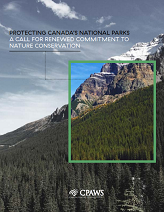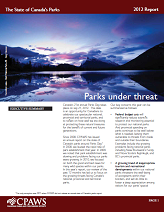Canada has committed to protecting 25% of its land and freshwater by 2025, on the way to 30% by 2030. It is essential to meet these targets to ultimately protect at least half of Canada, which is necessary to conserve the country’s natural landscapes and unique wildlife. Check out the Resources section for our latest reports and other publications.
Join the movement to protect 30% of land and ocean in Canada by 2030.
Canada’s Terrestrial Protected and Conserved Areas

Protected Area
A clearly defined geographical space that is recognized, dedicated, and managed through legal or other effective means to achieve long-term conservation of nature and associated ecosystem services and cultural values (IUCN Definition, 2008).
Public Land
Land that is held and managed for the people of Canada by our federal, provincial, territorial, and Indigenous governments. Ninety percent of Canada’s land is publicly held, which is why it is important to create protected areas that are owned and managed by the public.
Ecosystem Services
The many varied benefits that humans gain from stable and functional ecosystems, such as air and water filtration, carbon storage, and mitigation of climate change impacts.
Protected areas are the cornerstone of conservation. Canada’s parks and other national, provincial, territorial, and Indigenous protected areas provide many benefits. These benefits include safeguarding biodiversity; providing clean air, fresh water, food, and medicines; mitigating the impacts of floods and droughts, and providing amazing outdoor recreational opportunities. Learn about the different types of protected areas in Canada and Other Effective Conservation Measures (OECMs).
Why are Parks and Protected Areas Important?
Conserving Biodiversity
Parks and protected areas are essential to conserving biodiversity and slowing the pace of extinction. Globally, parks and protected areas safeguard habitat for wildlife and provide them with space to feed, raise their young, and exist with minimal human interference. Canada recognizes the importance of conserving biodiversity, having signed on to the United Nation’s Convention on Biological Diversity in 1992.
Advancing Science, Research, and Education
Parks and protected areas serve as environmental benchmarks for measuring the health of natural systems. They also help us to understand the effects of habitat loss and degradation, climate change, pollution, invasive species, and other threats.
Research plays an important role in the protection of landscapes and their biodiversity. Protected areas research can be categorized according to two aims: 1) to support effective management, and 2) to foster a better understanding of the impacts of both natural and human processes.
In parts of the world where most of the landscape has been transformed by agriculture or industry, protected areas remain the only natural or near-natural ecosystems. As such, protected areas provide unique opportunities to educate people about the natural world.
Improving Health and Well-Being
Parks and protected areas provide important opportunities for people to connect to and learn about nature. Nearly 90% of Canadians enjoy participating in nature-based activities. Being in nature has been linked to reduced anxiety and stress, shorter hospital stays, lower heart rate, increased attention span, and improved mood. Experiencing nature is especially beneficial for the mental and physical development of children. Read more in our report, Healthy Nature Healthy People.
Diversifying the Economy
Parks and protected areas diversify the economy through ecotourism, tax generation for local governments, and the creation of jobs for local communities. Ecotourism allows people to celebrate both natural and cultural heritage. Read more in our economic backgrounder.
Providing Ecosystem Services
Parks and protected areas provide a myriad of benefits by keeping ecosystems intact. These benefits include air and water filtration, carbon storage, and flood and drought mitigation.
Providing Food and Medicine
Parks and protected areas provide people with wild plants, wild game, fish, herbs, and important sources of medicine.
Reducing the Impacts of Climate Change
Parks and protected areas provide space for plants and animals to adapt to environmental changes and shield them from extreme weather effects.
Investing in Future Generations
Parks and protected areas often represent systems that are natural or semi-natural, and most closely resemble how ecosystems looked and functioned prior to the industrial and agricultural revolutions and urban expansion. Maintaining natural spaces will ensure that people will continue to have the opportunity to experience, enjoy, and benefit from them.
The Link Between the Biodiversity and Climate Crises
Climate change and biodiversity loss go hand in hand. Climate change is the third most significant driver of the ongoing loss of nature. The impacts of a 1˚C increase in the global average temperature were already being experienced in 2019. If we allow greenhouse gas (GHG) emissions to remain at current levels and global temperatures to increase by more than 1.5˚C we will witness the collapse of key ecosystems.
Here are a few examples of how biodiversity loss and climate change are interconnected:
- Changes in climate (temperature and precipitation) are impacting Canadian ecosystems. In the Boreal forest, deciduous trees often grow back after fires, instead of the coniferous trees that are typical of this type of forest. This impacts other species within the ecosystem, which may move to more appropriate places or adapt in other ways. Species that are already vulnerable due to habitat loss or degradation may become locally extinct.
- The degradation of ecosystems and ensuing loss of biodiversity will make it harder for people to adapt to climate change. For example, draining wetlands results in the loss an ecosystem that absorbs water. These are important functions in areas where flooding events are likely to increase as a result of climate change.
- Degraded ecosystems are more vulnerable to natural disturbances, such as fires or insect infestations. These events are more likely to occur as the global climate changes, and may result in increased GHG emissions from ecosystems that have been storing carbon over long periods of time and further contribute to climate change.
The bottom line: biodiversity loss and climate change are connected, and we cannot address one crisis without considering the other. The good news is that there is an increasing awareness in Canada that we must address climate change and biodiversity loss simultaneously. Nature-based climate solutions are the way forward. By reducing ecosystem degradation and loss in Canada, we can reduce our GHG emissions and help ecosystems and people be more resilient to climate change.
How Much is Enough?
CPAWS is at the forefront of identifying and implementing Canada’s conservation agenda. In 2010, the federal government committed to the protection of at least 17% of Canada’s public land and freshwater by 2020. In 2018, CPAWS was instrumental in the federal government’s decision to invest $1.3 billion in nature conservation. As a result of this commitment and investment, several large conservation areas were established in 2020, bringing Canada’s total protected and conserved land and freshwater to over 12% of the country.
Although the 17% target is broadly referenced in the news and in government communications, it is a political target, not a scientific one. In fact, 17% falls short of science-based conservation targets. In our 2019 Parks report (Canada’s Nature Emergency: Scaling up Solutions for Land and Freshwater), we call for protecting half of Canada’s public lands and freshwater by 2050 with a milestone target of protecting 30% by 2030, and outline a 10-step plan to put Canada on the path to reaching those targets.
Scientists are increasingly coming to the conclusion that protecting and restoring around half of the Earth’s land and freshwater is necessary to sustain nature, as well as the essential ecosystem services it provides to people. The proposal to conserve half the Earth’s land extends back to at least 1972 in the scientific literature.
In their 2019 election platform and subsequent mandate letters, the federal government committed to more ambitious conservation targets, including protecting 25% of land and freshwater by 2025 and 30% by 2030. CPAWS and partners are working on a road map to help Canadian governments achieve this conservation agenda.
Threats and Challenges
Canada’s parks and protected areas face many challenges. Parks in Canada are typically small and isolated, preventing wildlife from moving easily between them. This is especially true in southern Canada, where parks are surrounded by urban areas or developed land.
Many parks are threatened by the impacts of industrial activities. These activities affect the regulation of water flow in rivers, contaminate air and water, and fragment habitats. Parks are also impacted by human use. While many parks in Canada strike a balance between recreational use and nature protection, some are heavily impacted by commercial development, overuse, and human-wildlife conflict.
CPAWS works with industry, government, local, and Indigenous groups to find solutions to these threats and challenges.
- Resources
- Protected Area Establishment
- Protected Area Management
- Regional Campaigns
- World Heritage Sites

September 2023
Biodiversity Strategy Joint Recommendations

2021
Report Card

Summer 2020
Bow Valley Parkway Visitor Survey
CPAWS’ mission is to protect at least half of Canada’s public land and water so that future generations can experience the country’s irreplaceable wilderness. Our milestone goal is to protect 30% of Canada’s land and freshwater by 2030 – a target that the federal government has committed to. We are working with federal, provincial, territorial, and Indigenous governments, as well as environmental groups, industries, concerned Canadians, and other partners to establish protected and conserved areas through appropriate legislative and/or regulatory methods.
CPAWS has a long history of working to ensure national parks are managed to protect the nature effectively.
The Canada National Parks Act states that the maintenance and restoration of a park’s ecological integrity is the number one priority in all national park management decisions.
Some of the issues CPAWS tackles to protect national parks include ski hill expansions, commercial development proposals, and lack of consultation with Canadians on development projects. Visit your regional CPAWS chapter website to learn about park issues near you!
Management Planning
Canada’s national parks, once established, are managed by the Parks Canada Agency. The Minister of Environment and Climate Change is also the Minister Responsible for the Parks Canada Agency.
The Canada National Parks Act states that each park must be governed by a management plan that includes:
- A long-term ecological vision for the park;
- A set of ecological integrity objectives and indicators for the park; and
- Provisions for resource protection and restoration, zoning, visitor use, public awareness, and performance evaluation.
Management plans are tabled in the House of Parliament and should be reviewed every five years.
Want to Learn More?
CPAWS’ Parks 101 document on Management Planning
Minister’s Round Table on Parks Canada
CPAWS’ submissions to the Rocky Mountain National Parks management planning consultation – July 2021
Canada is responsible for managing 10 Natural World Heritage Sites and one Mixed World Heritage Site.
Natural World Heritage Sites are natural places that have outstanding global value for science, conservation, and/or natural beauty. As a State Party responsible for these places, Canada must adhere to the Convention Concerning the Protection of World Cultural and Natural Heritage to manage these sites for both the Canadian and global community.















